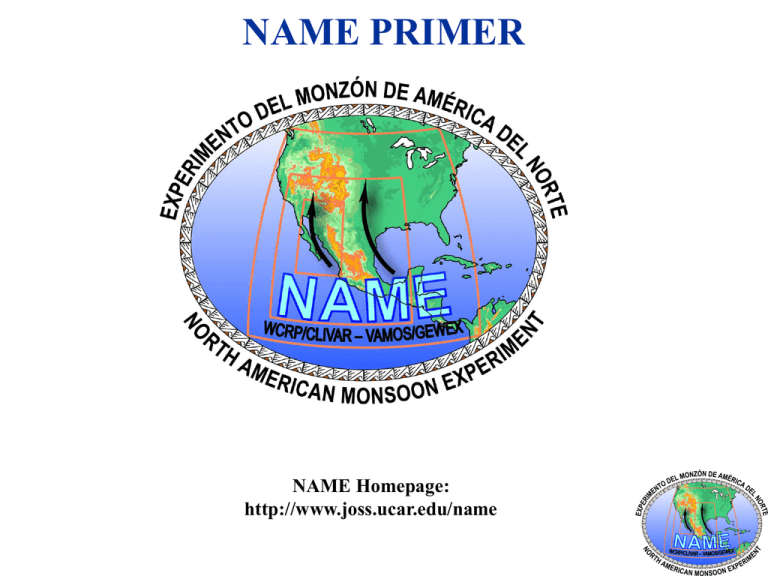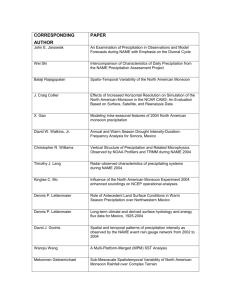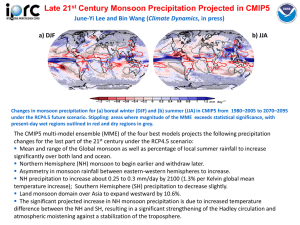NAME PRIMER NAME Homepage:
advertisement

NAME PRIMER NAME Homepage: http://www.joss.ucar.edu/name OUTLINE 1. PROGRAM RATIONALE AND OBJECTIVES 2. NAME 2004 FIELD CAMPAIGN • Field Observation Networks (Tiers I, II, III) 3. NAME MODELING AND DATA ASSIMILATION • Science Questions and Activities (Tiers I, II, III) WHAT IS NAME? NAME is an internationally coordinated, joint CLIVAR – GEWEX process study aimed at determining the sources and limits of predictability of warm season precipitation over North America. RATIONALE FOR NAME • Global and regional models do not accurately simulate or predict warm season precipitation, especially in tropical / subtropical land-ocean interaction regions. • NAME seeks improved understanding of the key physical processes that must be parameterized for improved simulations and predictions with coupled models. • A fundamental first step towards improved prediction is the clear documentation of the major elements of the NAMS and their variability within the context of the evolving O-A-L annual cycle. ROLE OF LOW-LEVEL JETS There are 2 important low-level jets that transport significant moisture to the continent and that play an important role in the diurnal cycle of precipitation. ROLE OF THE LAND SURFACE • The land surface has its strongest influence during the warm season (continents are warm; evaporation is large). • The land surface has many memory mechanisms (e.g. soil moisture, snow, vegetation) that may influence monsoon variability. ROLE OF OCEANIC FORCING OF CONTINENTAL CLIMATE ANOMALIES • Ocean memory components evolve slowly and are to some degree predictable in their own right. • Warm season correlations between SST and continental precipitation are at least marginal. • Motivates studies of remote-vs-local SST’s; antecedent influences; influences of MJO, ENSO,PDO. NORTH AMERICAN MONSOON EXPERIMENT (NAME) HYPOTHESIS Topographic and Sea-Land Influence The NAMS provides a physical basis for determining the degree of predictability of warm season precipitation over the region. Intraseasonal Variability Boundary Forcing? YEAR (2000+) Planning Preparations Data Collection Principal Research Data Management 00 01 02 03 04 05 06 07 08 --------------| --------------| - - - ----------------| ----------------------------------| -----------------------------------------| OBJECTIVES: Better understanding and simulation of: • warm season convective processes in complex terrain (TIER I); • intraseasonal variability of the monsoon (TIER II); • response of warm season circulation and precipitation to slowly varying boundary conditions (SST, soil moisture) (TIER III); • monsoon evolution and variability (TIER I, II, III). NAME IMPLEMENTATION • Empirical and modeling studies that carry forward the joint PACS/GAPP Warm Season Precipitation Initiative (2000 onward), and initiate new elements. • NAME Field Campaign (JJAS 2004) including build-up, field, analysis and modeling phases. US CLIVAR PAN AMERICAN PROCESS STUDY TIMELINES NAME PROJECT STRUCTURE Science Working Group Project Office Program Managemen t •NAME Forecast Operations Center •NAME International Project Support Team http://www.joss.ucar.edu/name NAME FIELD OBSERVATIONS (JJAS 2004) Enhanced Precipitation Gauge Network R.V. Ron Brown Radiosondes/PIBALS Radar/Profiling/Radiosondes NAME FIELD NETWORKS (JJAS 2004) Tier I Instrumentation – – – – – – – – – – UHF wind profiler (1) VISS (5) (SMN sounding+UHF-RASS profiler) NCAR ISS (4) (UHF-RASS profiler+sounding +sfc) SMN 5cm Doppler radars (4) (3 Enterprise; 1 Eriksson) 10cm Doppler-polarimetric radar (NCAR S-POL) Ron Brown shipboard platform (VISS, 5cm Doppler radar, Sfc fluxes) Mexican Research Vessels Buoys (1 ASIS; ??) NOAA/ETL shipboard flux system (on UNAM/PUMA) Advanced Lightning Direction Finder (5) – – – Raingauges (100 event logging; 1600 simple) Research Aircraft (NOAA P-3, NASA P-3B) Soil Moisture Sensors Tiers II and III Instrumentation – – Radiosonde PIBAL Addressing NAME Oceanographic Science Proposed Location of the R/V Ron Brown During NAME IOP Instrumentation • R/V Ron Brown (radar, surface fluxes) • ASIS Buoy (central GOC) •SST’S?? • Mexican Research Vessels •Wind profilers? Objectives • Surge origins • Sources of moisture and transports • Precipitation statistics including diurnal cycle • Structure of southern end of GC LLJ • Surface fluxes/Ocean coupling Additional Observations: -buoys in GOC -ships of opportunity (Paco) NAME FIELD OBSERVATIONS (Tiers I, II and III) Bolded red – NSF Deployment Pool; bolded blue –other NSF support; black – NOAA OGP or NASA THP Platform / Data Integrated Sounding Systems /S-POL Radar Instrumentation and Tier Sponsor - Status PI's R. Carbone (NCAR), R. Cifelli(CSU), R. Johnson (CSU), M. Moncrieff (NCAR), W. Petersen (UAH) S. Rutledge (CSU) 4 Integrated Sounding Systems; S-POL Doppler Polarimetric radar; Upgrade for 4 SMN 5-cm Doppler radars; 6 UHF profilers; RV Ron Brown(Tier I) NCAR/ATD NSF Field Deployment – NOAA/ETL and/or AL NOAA/OGP - Proposed C. Fairall (NOAA/ETL), K. Gage (NOAA/AL), G. Kiladis (NOAA/AL) Lightning Detectors 5 sites (Mexico) 8 sites (US) (Tier I, III) NSF/Hydrology and Physical Meteorology Proposed W. Petersen (UAH), P. Krider (UAZ), S. Rutledge (CSU) , R. Blakeslee (NASA), S. Goodman (NASA), B. Maddox (UAZ) Radiosondes (Mexico) 17 sites (up to 2x-4x daily) (Tier I-III) NOAA/OGP - Proposed M. Cortez (SMN), A. Douglas(Creighton) , M. Cortez SMN Pilot Balloons 6 US sites / 25 Mexican sites (Tiers I-II) NOAA/OGP - Proposed M. Douglas (NSSL) NOAA P-3Aircraft Doppler radar, dropsondes, Flight level inst. (Tier I) NOAA - Proposed M. Douglas (NOAA), W. Cotton (CSU) D. Jorgensen (NOAA), Surface Observations Network (Mexico) SMN - N/A N/A Coop Raingauge Network 79 synoptic stations; 60 automated met stations; 12 radars; 17 radiosonde sites; 1600 simple gauges (Tier I-II) NOAA/OGP - Proposed Lobato/ Higgins ASIS Buoys (Mexico) 1 site (central GOC) (Tier I) CICESE - Funded F. Torres (CICESE) GPS (Suominet) 3 sites (NW Mexico) (Tier I) NOAA/OGP - Proposed A. Hahmann (UAZ) ,R. Kursinsky (UAZ) C. Sosa (IMADES) , C. WattsIMADES Hydrometeorology Network (Mexico, AZ) ; Soil Moisture Field Campaign; NASA P-3B Aircraft Unified Geographic Network (Terrain, Hydrography, Landcover); Agromet stations; soil moisture sensors (Walnut Gulch,AZ, Hermosillo (Tier I) 90-100 event logging raingauges- funded (OGP) D. Gochis (NCAR), J. Shuttleworth UAZ, C. Watts (IMADES), J. Garatuza ITSON, T. Cavazos (CICESE) D. Lettenmaier (UW), D. Lettenmaier (UW), T. Jackson SMN Radars Profilers, Soundings Ship (see detail below) NASA THP NAME Tier-1 Scientific Questions 1. 2. 3. 5. How are low-level circulations along the Gulf of California / west slopes of the Sierra Madre Occidental related to the diurnal cycle of moisture and convection? (low-level circulation) What is the relationship between moisture transport and rainfall variability (e.g. forcing of surge events; onset of monsoon details)? (moisture transport and budget) What is the typical life cycle of diurnal convective rainfall? Where along the western slope of the Sierra Madre Occidental is convective development preferred? (diurnal cycle) What are the fluxes of water (and energy) from the land surface to the atmosphere across the monsoon region, and how do these fluxes evolve in time during the warm season? (role of land surface) (see other questions in the NAME Science and Implementation Plan) NAME Tier-2 Scientific Questions 1. 2. 3. 4. What is the nature of the relationship between the MJO, tropical cyclone activity and monsoon precipitation? (role of MJO) How important are interactions between tropical easterly waves and mid-latitude westerly waves in the prediction of monsoon precipitation? (dynamical linkages) What is the physical setting for the bimodal distribution (i.e. wetdry-wet) in warm season precipitation over Mexico and Central America and what factors influence its interannual variability? (double peak structure) What are the dominant sources of precipitable moisture for monsoon precipitation over southwestern North America? (moisture sources, GOC-vs-GOM) (see other questions in the NAME Science and Implementation Plan) NAME Tier-3 Scientific Questions 1. 2. 3. 4. What are the relative roles of local (e.g. Gulf of California) and remote (e.g. tropical Pacific) SST’s on the predictability of the NAMS? (role of SST’s, simultaneous and antecedent) Can numerical models reproduce the observed summer precipitation in average years and years with ENSO influence? (role of ENSO) What are the influences of the core monsoon region on the larger scales (e.g. relationship between precipitation variability in the SW and Great Plains)? (dynamical linkages) What are the relationships between extreme weather events (e.g. floods, droughts, heat waves, hurricanes), climate variability and long-term trends? (extreme events). (see other questions in the NAME Science and Implementation Plan) THE NAME MODELING –OBSERVATIONS TEAM Charge: • Provide guidance on needs and priorities for NAME 2004 field observations. “NAMAP” – 6 modeling groups; 1990 monsoon, global and regional models • Identify the path to improved warm season precipitation prediction: “White Paper” - NAME Modeling and Data Assimilation R&D “NAME Modeling Workshop (College Park, MD, June 6th) ” • Identify additional process studies necessary to reduce uncertainties in coupled models. MODEL DEVELOPMENT IN NAME Premise: • The leading factors that limit precipitation forecast skill in both global and regional models during the warm season are deficiencies in how we model “local” processes that modulate deep convection. • In order to achieve the desired improvements, NAME will focus on the diurnal cycle of convection in the core monsoon region of NW Mexico, a region of complex terrain and land/sea contrasts. • NAME 2004 will provide improved estimates of the 3-d structure of the monsoon and its variability on diurnal to monthly time scales. ROLE OF NAME 2004 OBSERVATIONS IN MODEL DEVELOPMENT The NAME modeling strategy recognizes three distinct roles that observations play in model development: (1) To guide model development by providing constraints on model simulations at the process level (e.g. convection, land/atm and ocean/atm interactions); (2) To help assess the veracity of model simulations of the various key NAMS phenomena (e.g. low level jets, land/sea breezes, tropical storms) and the linkages to regional / larger-scale climate variability; (3) To provide initial and boundary conditions, and verification data, for model predictions. NAME IN VAMOS VAMOS PANEL PROCESS STUDIES NAME MESA VOCAL VAMOS MODELING GROUP NAME MODELING AND OTHER MODELING ACTIVITIES Linkages: • What modeling groups do we link to? GEWEX • • • GLDAS GLASS CEOP CLIVAR • • • WGSIP NSIP Other groups doing ENSO predictability DATA ASSIMILATION AND ANALYSIS Linking the Tiers Objectives: 1) To better understand and simulate the various components of the NAMS including: * moisture surge – precipitation relationships; * tropical easterly wave – midlatitude (westerly) wave relationships; * components of the moisture budget and sources of moisture; * basic seasonal evolution (life cycle) of the monsoon. 2) To quantify the impact of the NAME 2004 observations; 3) To identify model errors and attribute them to the underlying model deficiencies. PREDICTABILITY AND FORECAST SKILL IN GLOBAL MODELS Objectives: 1) To examine the predictability of warm season precipitation over the NAM region; 2) To quantify error growth due to model errors versus that due to uncertainties in analyses and boundary conditions; 3) To assess the value of NAME observations for prediction; 4) To help define field campaigns to follow NAME 2004. Key Questions (ultimately critical for climate prediction): 1) How is the life cycle of the monsoon related to the evolution of oceanic and continental boundary conditions? 2) Can models reproduce the observed summertime precipitation in average years and years with ENSO influence? Models On board: NSIPP, NCEP/GFS Possible: GFDL, NCAR NAME MODELING, DATA ASSIMILATION AND PREDICTION TIMELINE Expected Outcome (Objectives) of June 6 Meeting * NAME “White Paper” roadmap for NAME Modeling, Data Assimilation and Prediction R&D - recommendations * timeline of specific activities tied to specific individuals / groups -recommendations for contacts not yet made -develop linkages to other field campaigns in S.W. U.S. and Mexico at this time (e.g. SALSA) NAME MODELING AND DIAGNOSTIC STUDIES (Tiers I, II and III) Activity Focus (and NAME Tiers) Sponsor and Status PI's Cloud Resolving Models Explicit convection; effect of terrain; mesoscale aspects of surges (Tier I) Proposed M. Moncrieff (NCAR) North American Monsoon Assessment Project (NAMAP) 1990 Monsoon (Tiers I,II) NOAA/OGP - Unfunded D. Gutzler (UNM) (6 modeling groups) Moisture Budget of IntraAmericas Sea Moisture Transport (Tier III) NOAA/OGP – Funded C. Zhang (RSMAS) Moisture Budget of NAME Moisture Transport / Precipitation (Tiers I-III) NOAA/OGP - Funded W. Higgins (NOAA/CPC) E. Yarosh (NOAA/CPC) Daily Precipitation Analysis (US_Mexico) Monitoring and Assessment of floods / droughts (Tiers I- III) NOAA/OGP - Funded W. Higgins (NOAA/CPC) W. Shi (NOAA/CPC) Diurnal Cycle and Precipitation Linkage to TRMM/GPM (Tiers I-III) NOAA/OGP - Funded P. Arkin (U. Md.) Subseasonal Variability Role of MJO/ Model Uncertainties (Tier II) NASA/IDS - Proposed S. Schubert (NASA/GSFC) Global / Regional Analyses and NAME Data Impact NCEP Analyses and Forecasts With Eta Model and Eta Model Data Assimilation System (EDAS) (Tiers I-III) Relationship of Precipitation characteristics to streamflow (Tier I) NOAA/OGP - Proposed K. Mo (NOAA/CPC) W. Higgins (NOAA/CPC) F. Meisenger (UCAR) H. Berbery (U. Md) D. Gochis (NCAR) B. Njissen (UAZ) WJ Shuttleworth (UAZ) Extend the long term land surface dataset retrospectively from LDAS (Tiers I and II). NOAA/OGP Hydrological interpretation of monthly to seasonal precipitation forecasts Assessment of land Surface Hydrologic Predictability NOAA/OGP D. Lettenmaier (UW) T. Cavazos-Perez (CISESE) CLIVAR - NAME DELIVERABLES • Climate models capable of predicting North American monsoon variability out to seasons in advance; • More comprehensive understanding of North American summer climate variability and predictability; • Infrastructure to observe and monitor the North American monsoon system; • Contributions to the assessment of climate variability and longterm climate change in the North American monsoon region; • Strengthened multinational scientific collaboration across the Americas.





![Eduardo A. Araujo-Pradere [], CIRES, University of Colorado, Solar Minimum](http://s2.studylib.net/store/data/013086460_1-158f16f4991b8d654a2183bbdcda9c6c-300x300.png)